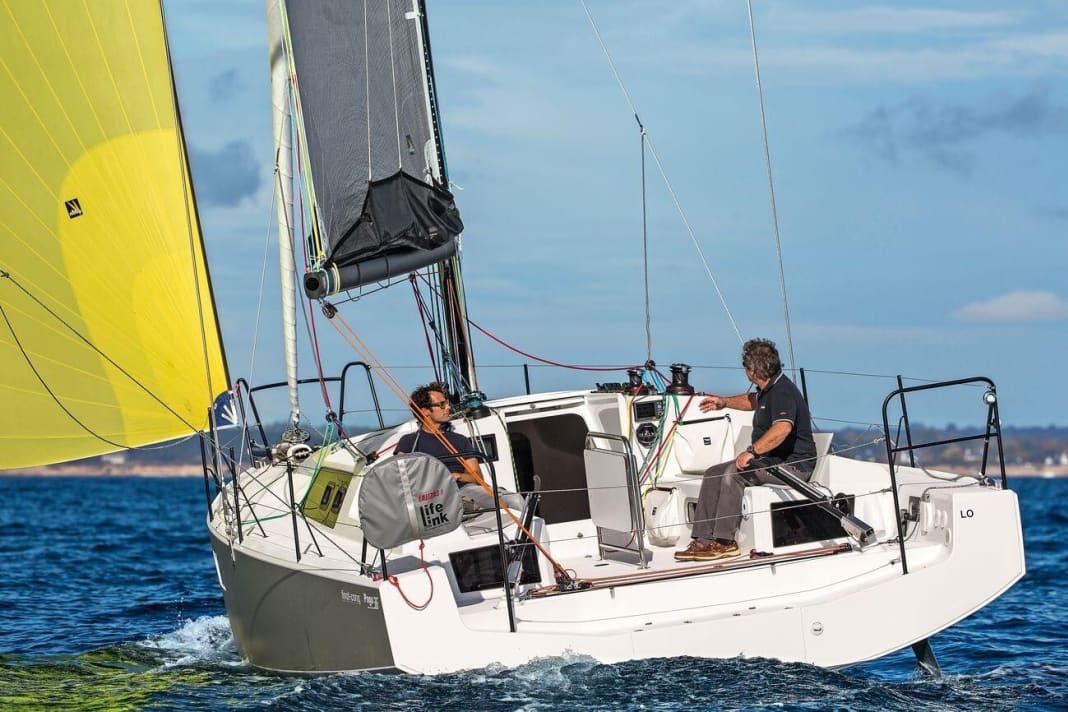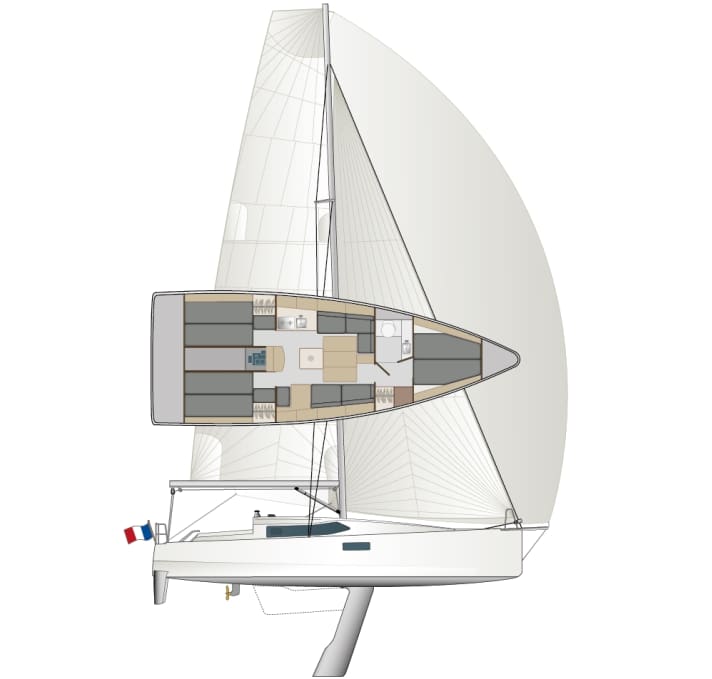





One thing is clear: a thoroughbred racing machine. You can tell just by the many straps on deck. And the wide rear end. And the two tiller posts. Probably one of the racers for the Vendée Globe. A little smaller perhaps, more like a Class 40? In the harbour of the picturesque town of Sainte-Marine in Brittany, a group of locals are puzzling over what is lying on the jetty in front of them. The supposed experts are not in agreement. Only about this: It must be a pretty wacky thing.
The answer to the riddle is clearly visible on the wide stern: Pogo 36. Charly Fernbach, Product Manager at Pogo Structures, explains to the inquisitive group: The vehicle is not a racer at all, but a sporty, fast touring boat of the latest design - a so-called fast cruiser, i.e. even sportier than a performance cruiser.
Even if, for the time being, there is a lot to be said in favour of this, especially in terms of appearance: The people at Pogo distance themselves quite firmly from comparing their boats with the genre of high-bred ocean racing yachts. The models in Pogo's cruising line are intended to be high-performance all-rounders, fun to sail as well as good-natured touring boats for the family. Boats that can do everything except sail slowly.
The Pogo 36 is the successor to the Pogo 10.50 from 2009, but the general DNA remains unchanged. The 10.50 was also an extraordinary, radical boat in its day. This has not changed with the successor.
With a projection of 4.00 metres, the Finot/Conq design is another 10 centimetres wider than the previous model, but the hull is also around 30 centimetres longer. With an aspect ratio of 2.7 metres, the Pogo 36 is wider than most boats of this size.
Other interesting performance cruisers
On the hunt for weight
All parts of the ship are built in the Breton shipyard, and all GRP components are also built using the complex but weight-saving vacuum infusion process with a foam core. In its ready-to-sail configuration, the Pogo 36 weighs just 3.8 tonnes. The boats of comparable competitors in this length class are usually at least one tonne heavier.
Pogo also builds the rudder blades and keels. 90 per cent of customers opt for the swing keel option; only one in ten ships is delivered with a fixed keel, which would be the standard, even for the 36s. The swivelling keel is operated hydraulically. The ship can be set down on it to dry out, but the rudders are too weak for this. Additional mudflats are required aft in tidal waters.
Exceptional keels
The design of the keels is sophisticated and rare. The keel fin has neither a cast iron core nor a stainless steel or carbon fibre shell, but consists entirely of a solid GRP composite. The mighty profile is also built using the vacuum infusion process. The shipyard does not want to reveal exactly how this works. The only thing that is certain is that it uses the process exclusively; no other manufacturer does it in the same or a similar way. The result is a relatively light keel shaft (swivelling keel and fixed keel) with an extremely efficient ballast component in the form of lead, because it acts deeply.
Due to the sheer width of the Pogo 36 aft and thanks to the radical frame shape with the pronounced chines and the flat underwater hull, this exceptional French model also has exceptional dimensional stability. The test shows that the new boat with its powerful rig leans to one side and can convert the pressure into speed from a certain position instead of heeling. When cruising downwind, the prototype with a canting keel very quickly returns to its target performance values after the tacks. The Pogo 36 sails at 6.4 knots hard on the wind, which blows at a speed of around 10 knots.
However, the ship is not an overly good cruiser. The turning angles are 90 degrees, which is a lot for a performance-orientated boat of this orientation. And pinching height is penalised with an immediate drop in performance. In addition, the Pogo 36 tends to enter the waves hard with its very voluminous bow section and flat underwater hull. It likes it more if you let it run properly, i.e. steer a little too low rather than too high - the wide glider's speciality is rough courses. And to make this really fun, additional sails such as a furling code zero or a gennaker are almost indispensable.
Innovative layout
The buyer also has the choice between two different rig variants. The classic aluminium mast with two spreaders is standard. A conventionally cut mainsail, i.e. one that is not flared at the top, is attached to it. In return, the mast is fitted with a backstay. The sporty alternative is the carbon fibre mast as on the test boat. The very stiff profile from Axxon Composites manages with just one spreader. The mainsail is square at the top, which means that a conventional backstay cannot be realised. However, experienced sailors can compensate for the lack of a backstay to a certain extent with the mainsheet lead all the way aft on the boom, the long traveller on the cockpit floor and the powerful boom vang.
The two tiller posts work very well. The helmsman sits comfortably on the dikes and has the handlebars directly in front of him. He can also steer without the tiller jib and thus in a controlled manner.
As a speciality, all halyards, sheets and trim lines on the Pogo 36 are led to the side of the companionway on no fewer than 20 halyard stoppers. Two large winches on each side ensure that you can work easily and clearly at the companionway.
However, the sheets for the mainsail and genoa are not directly accessible to the helmsman from his position at the tiller. He has to leave his position to trim the sails. This is not tragic in this case because the Pogo with its two rudder blades holds its course even without an active helmsman. Although the almost non-existent rudder pressure requires attention when steering, it conserves power reserves when operating with the autopilot.
If you want, you could also have double steering wheels fitted. The shipyard offers this for a corresponding surcharge.
Focus on functionality
Ultimate lightweight construction also characterises the interior below deck. Instead of doors, only fabric curtains are provided, as are the covers for the storage compartments. The interior is dominated by the blank white of the composite structures. The look is simple, sober and tidy. There is no cosy ship-like atmosphere.
On the other hand, the boat impresses with its well thought-out functionality, especially in the galley and navigation areas. You can work well and safely both in the harbour and at sea, and there is plenty of storage space that can be used sensibly.




The Pogo 36 comes with two spacious double cabins aft. Two people can sleep in the forward cabin and, if required, someone else can sleep on the starboard sofa berth. Naturally, all berths are equipped with leeches from the shipyard. The wet room with toilet, washbasin and shower option is now also located in the foredeck. On the predecessor model Pogo 10.50, the bathroom was installed aft, but there was no second aft cabin.
At first glance, the interior of the new models appears rather unadorned, but the quality is nevertheless very good. The surfaces are as good as perfect. For weight reasons, no inner shells were used, but the hulls and decks are accurately filled and sanded on the inside - an elaborate process.
The new Pogo 36 costs 240,140 euros ex shipyard. In order to actually get away with it, at least one set of upwind sails must be purchased. In comparison, however, this is still a good and fair offer. The boat is not only neatly built, but also very high quality and richly equipped ex shipyard.
This article first appeared in YACHT 01/2017 and has been edited for this online version.

Technical data
- Designer Finot/Conq
- CE design category A
- Hull length 10.81 m
- Width 4.00 m
- Draught/alternative 2.10/1.10-2.80 m
- Weight 3.8 tonnes
- Ballast/proportion 1.4 t/37 %
- Mainsail 45.0 m2
- Furling genoa (106 %) 39.0 m2
- Engine (Volvo P.) 21 kW/29 hp
Hull and deck construction
- GRP sandwich construction with foam core, built using the vacuum infusion process. Iso-polyester resins
Base price ex shipyard
- 240.140 €
Guarantee/against osmosis
- 2/5 years
Shipyard and distribution
- Pogo Structures, 29120 Combrit (France); www.pogostructures.com
YACHT rating
Very consistently built performance cruiser from France with high performance potential. The Pogo 36 is uncompromisingly designed for lightweight construction, but not necessarily only for regatta purposes. Attractively priced
Design and concept
- + Extremely versatile alignment
- + High-quality, unsinkable design
- + Consistent weight optimisation
Sailing performance and trim
- + High performance potential
- + Fast reactions on the rudder
Living and finishing quality
- + Good functionality in all areas
- - Forward berth relatively short
- - Few ventilation options
Equipment and technology
- + High-quality basic equipment
- + Functioning deck layout

